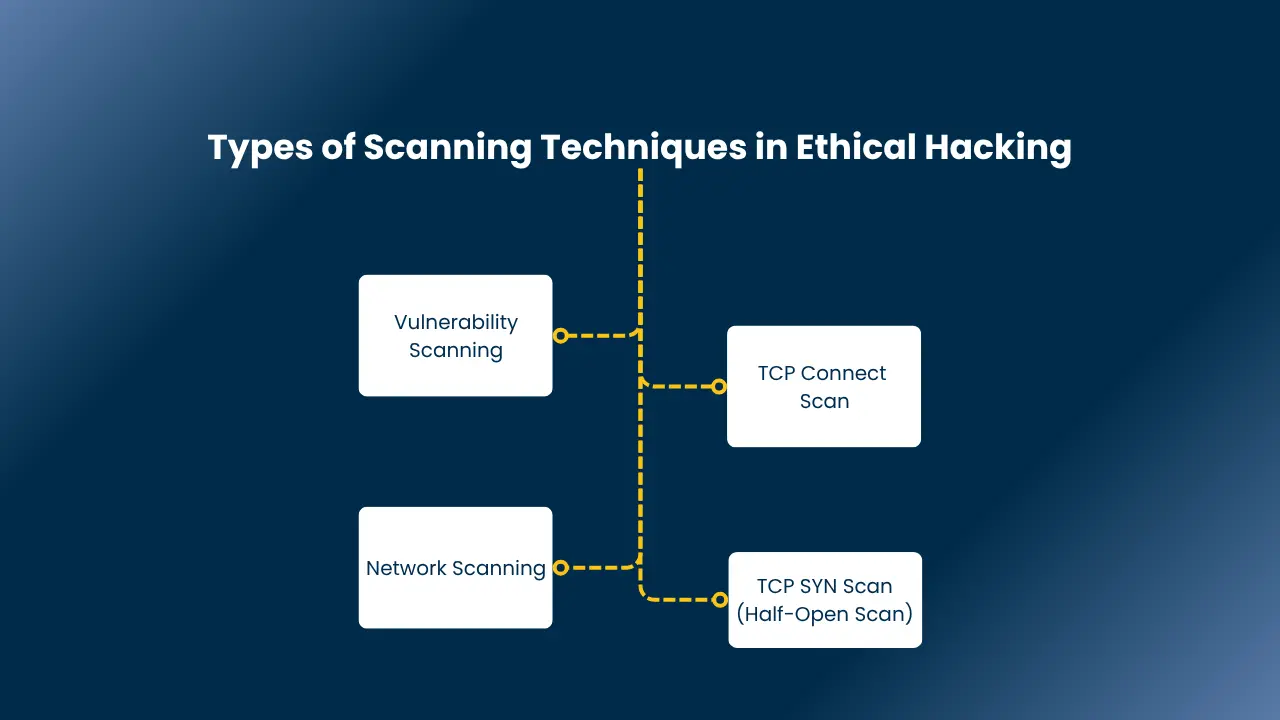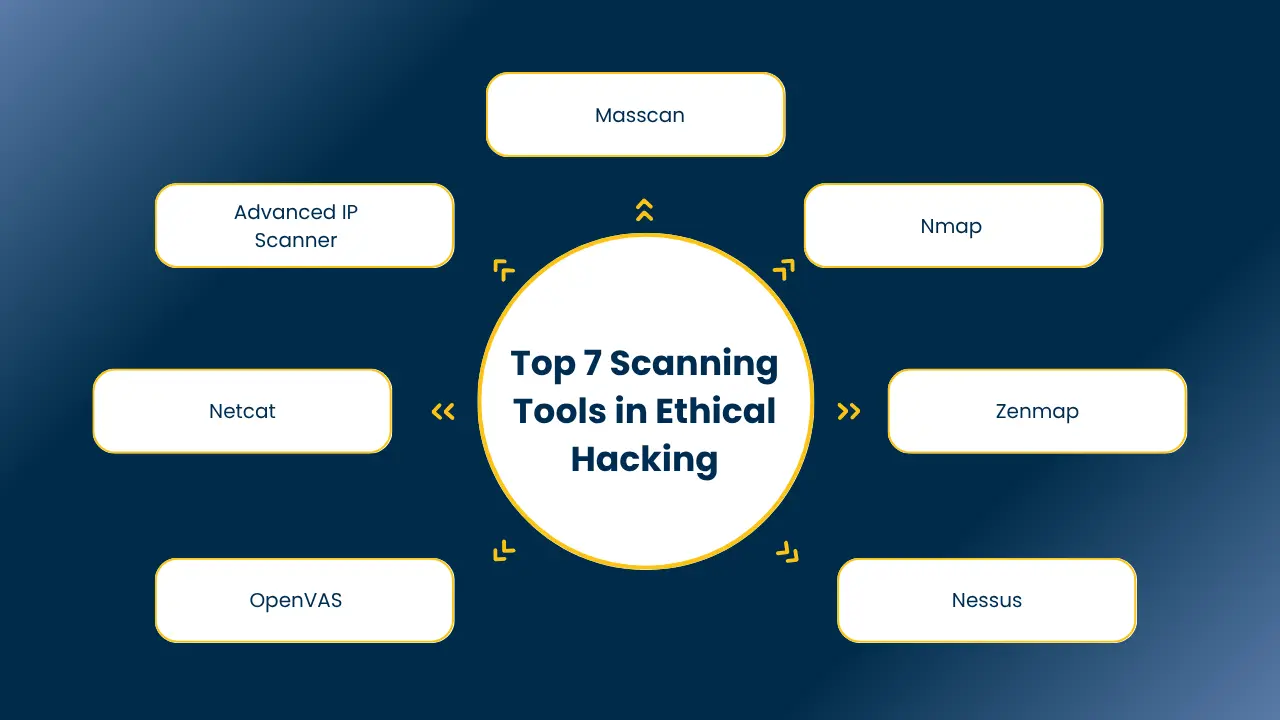Top 7 Scanning Tools in Ethical Hacking and their Types in 2025

In the realm of cybersecurity. Scanning tools in ethical hacking are crucial in uncovering vulnerabilities prior to attackers targeting them. Since such tools assist ethical hackers in detecting vulnerabilities in a system or network. They do this by conducting extensive scans. Whether it is ports, services, or even open doors left behind by poorly configured firewalls. In addition,
In this blog, we will examine the various scanning methods in ethical hacking, types of scanning tools in ethical hacking, and the most used tools today. Moreover, whether you are a beginner in cybersecurity or preparing for a pen-testing career. Knowledge of scanning is a no-go skill.
What are Scanning Attacks?
In the field of ethical hacking, scanning attacks are meant to actively scan a network or system to identify key information such as live hosts, open ports, and operating services. Scanning tools in ethical hacking is used to evaluate potential vulnerabilities that can be taken advantage of by attackers. It’s an integral part of the vulnerability assessment stage, utilized in order to chart the target environment prior to more extensive penetration testing India.
There are two primary methods of scanning techniques in ethical hacking:
1. Active Scanning: It sends packets to target systems directly. It can be intrusive and impact performance or trigger alarms but gives real-time and precise information.
2. Passive Scanning: It uses listening on network traffic without having contact with the target, so it is stealthy but slower and restricted in scope.
Although scanning is often confused with port scanning, it’s a more general process. Ethical hackers use scanning to:
- Identify open and closed ports
- Recognize exposed services (such as FTP, SSH, or Telnet)
- Map network infrastructure
- Make exploitation or traffic redirection preparation
What are Port Scan Attacks?
A typical type of scanning is the port scan, in which a hacker initiates packets into a series of ports on a target host to detect which of them respond. For example, SYN scanning (also known as port scanning in ethical hacking) initiates SYN packets and waits for replies to check whether ports are open, closed, or filtered.
The ping sweep method sends different ICMP echo requests over IP ranges to determine which hosts are online. The techniques, although basic, are very valuable to both defensive and offensive strategies.
Cybersecurity experts need to understand and recognize scanning attacks and knowing how to perform the same ethically is an indispensable skill for anyone who wants to venture into this arena.
Also Read: Top 10 Ethical Hacking Course in Ahmedabad: Duration & Certification
Types of Scanning Techniques in Ethical Hacking
Knowledge of the different scanning methods is fundamental in ethical hacking to expose concealed vulnerabilities, make network maps, and monitor system behavior. These methods are used as the basis of further vulnerability scanning in ethical hacking and penetration testing.
Let’s discuss the most common scanning techniques in ethical hacking.

1. TCP Connect Scan
The TCP Connect scan is the most simple scanning method. It makes a complete TCP connection to the target system by performing the three-way handshake. After establishing a connection, the scanner identifies whether a port is open, closed, or filtered.
Although this scan is true, it’s also easily picked up by firewalls and intrusion detection systems (IDS), so it’s not as stealthy. This type of technique is only used in environments where detection isn’t a priority, such as internal audits or sanctioned testing.
Use case: Full port analysis where detection is not an issue.
2. TCP SYN Scan (Half-Open Scan)
The TCP SYN scan is also known as a “half-open scan” because it sends the first SYN packet only to a target port and waits for acknowledgment without following through with the handshake. If a SYN-ACK reply comes from the port, then it’s open. If an RST (reset) is seen, then the port is closed.
This method is more stealthy than a TCP connect scan and tends not to be detected by security software. It’s one of the most popular port scanning methods used in ethical hacking it’s so balanced between speed, precision, and stealth.
Use case: Stealth scanning when you don’t want to alert the target system.
3. Network Scanning
Network scanning tools in ethical hacking is employed to find out active devices, their IP addresses, and the services that run on a network. These types of network scanning aids ethical hackers in:
- Mapping network topologies
- Discovering hidden devices
- Identifying live hosts and open services
- Uncovering probable entry points
Network scanning is fundamental in the initial stage of ethical hacking, which assists in creating a proper image of the target environment. It can be manually carried out, but network scanning tools are mostly used in ethical hacking like Nmap, Advanced IP Scanner, or Angry IP Scanner.
Use case: Finding all devices and services that are operating on a target network.
4. Vulnerability Scanning
Vulnerability scanning takes the process of discovery a step further—evaluating the services and systems for known vulnerabilities. This is done through the use of automated scanners that compare the system that is scanned against a regularly updated database of known vulnerabilities (such as CVEs). Scanners assist with uncovering:
- Unpatched software
- Misconfigurations
- Weak credentials
- Known exploit paths
Most widely used vulnerability scanners are Nessus, OpenVAS, and Qualys. They produce in-depth reports on the identified vulnerabilities, which are used by ethical hackers and companies to determine the order of fixing the problems.
Use case: Discovery and identification of known vulnerabilities within systems and applications.
Types of Port Scanners in Ethical Hacking
Port scanners are crucial ethical hacking tools that enable professionals to identify open, closed, or filtered ports on the target system. Ethical hackers can gauge exposed services and the extent to which they are vulnerable to exploit by identifying these ports.
The following are most frequently used port scanning tools in ethical hacking:
1. Ping Scans
Ping scans are also one of the easiest ways to determine if a host is online. This sends ICMP echo requests to a series of IP addresses. If there is a response from a system, that system is active.
Even though not an actual port scan, ping scanning is normally the precursor to a network scan to determine live hosts prior to more thorough exploration. ICMP responses can be inhibited on some networks, which may render this scan ineffective.
Purpose: Rapidly discover active systems within a network
Relevance: Utilized as part of network scanning tools during ethical hacking to minimize scanning scope
2. SYN Scans (Half-Open Scans)
Synonymously referred to as half-open scans, SYN scanning is amongst the most prevalent port-scanning techniques used in ethical hacking. Rather than doing a full TCP handshake, it sends out a SYN packet and waits to see an SYN-ACK (that the port is open) or an RST (that it’s closed).
It is quicker and less conspicuous than a TCP Connect scan and usually evades detection by intrusion detection systems.
Purpose: Identify open ports without the need to make a full connection
Relevance: Best suited for port scanning in ethical hacking where stealth is required
3. XMAS Scans
XMAS scans are a more sophisticated and less used method of evading simple firewalls and identifying system behavior. They push out a packet with the FIN, URG, and PUSH flags all in the “on” position looking like a feature-decorated packet, thus earning the name “XMAS.”
The scan is based on the reaction of various operating systems to unusual flag combinations:
If a port is closed, the target will respond with an RST packet.
If a port is open, it will not respond to the packet (i.e., no ack), or it could be assumed to be an open port.
Purpose: Detect open/closed ports based on particular TCP behavior
Relevance: Employed when attempting to circumvent detection or benchmark firewall reactions
Also Read: Best Certified Ethical Hacking (CEH) Courses to Join in Lucknow – 2025 List
Top 7 Scanning Tools in Ethical Hacking
Scanning tools in ethical hacking are the eyes and ears of ethical hackers in the cybersecurity world. Through these tools, professionals can find vulnerabilities, inspect systems, and evaluate network security before they are exploited by malicious agents. From network scanning to port scanning, and vulnerability scanning, the appropriate tool can identify anything from open services to antiquated software versions.
Following are some of the most commonly employed scanning tools in ethical hacking on all kinds of operating systems, including Windows.

1. Nmap
Nmap (Network Mapper) is perhaps the most popularly used network scanning tool for ethical hacking. It’s an open-source tool that enables ethical hackers to find hosts, identify open ports, find services, and even identify operating system fingerprints.
Main Uses: Port scanning, service discovery, OS fingerprinting
Platforms: Windows, Linux, macOS
2. Zenmap
Zenmap is the Nmap GUI, making it easy to use yet still having robust features. It displays network topologies and scan output, which comes in handy when dealing with complicated environments.
Main Applications: Network visualization, simple scanning workflows
Operating Systems: Windows, Linux
3. Nessus
Nessus is one of the top vulnerability scanning tools for ethical hacking purposes, used to identify software defects, misconfigurations, and missing patches. It cross-references scanned information with its large vulnerability database and generates in-depth reports.
Key Applications: Vulnerability scanning, compliance scan
Platforms: Windows, Linux
4. OpenVAS
A free and open-source version of Nessus, OpenVAS is utilized for bulk vulnerability scanning. It offers periodic updates for identifying newly found vulnerabilities.
Key Applications: Vulnerability scanning, network security scan
Platforms: Linux (Windows through clients)
5. Netcat
Generally known as the “Swiss Army knife” of network tools, Netcat enables ethical hackers to read from or write to data over network connections. It’s light and has capabilities of port scanning, banner grabbing, and file transfers.
Main Uses: Port scanning by hand, remote access testing
Platforms: Windows, Linux
6. Advanced IP Scanner
It is among the most effective scanning tools in ethical hacking for Window users. It offers quick network scans, identifies devices, and provides remote access features like RDP and Wake-on-LAN.
Key Uses: Windows-based network scanning
Platforms: Windows only
7. Masscan
Masscan is a high-speed scanner. It is capable of scanning the whole internet within minutes and is commonly utilized for quick reconnaissance prior to in-depth analysis.
Key Uses: High-speed port scanning, bulk reconnaissance
Platforms: Linux, Windows
Conclusion
Mastering scanning tools in ethical hacking is essential for anyone pursuing a career in cybersecurity. These tools help ethical hackers identify vulnerabilities, assess risk, and secure systems before threats emerge. From port and network scanning to in-depth vulnerability assessments, each tool and technique plays a vital role in proactive defense.
As cyber threats evolve, so must your skills. At Orbus Cybersec Trainings, we offer hands-on training on current scanning tools and methods to enable you to gain a good grip in ethical hacking. Scan smart, and defend strong with Orbus your partner.
Understand how Orbus can help your career!
Speak with an Expert Now!
FAQ's
What are scanning tools?
Scanning tools refer to the cybersecurity tools employed to find open ports, live hosts, operating services, and vulnerabilities in systems or networks.
What is scanning and its type?
Scanning refers to the practice of testing systems for information. Popular forms are port scanning, network scanning, and vulnerability scanning.
What are three types of scanning in ethical hacking cybersecurity?
- Port Scanning
- Network Scanning
- Vulnerability Scanning
What are 5 applications of scanning in cybersecurity?
- Identify active hosts
- Determine open ports
- Identify running services
- Detect vulnerabilities
- Map network topology




